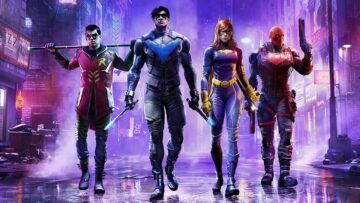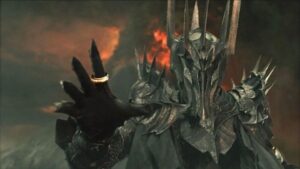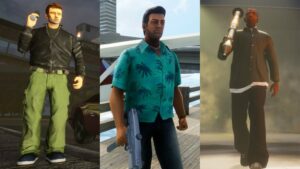Returnal is a game defined by cycles. Death is never the end in Returnal, and each run allows you to gain a better understanding of Housemarque’s snappy gameplay, unlock more overarching elements like items and gear, and dive deeper into its fascinating and complex story.
But to fully understand the incredible depths to which Housemarque integrates cycles into every facet of Returnal, look no further than The Derelict Citadel, a level that offers a commentary on the very idea of cycles in surprising and enthralling ways. To find out how it all came together, and how it beautifully illustrates the mechanical and narrative cycles at work, IGN spoke with members of the Housemarque team to explore how The Derelict Citadel offers an important capsulation of how Returnal keeps you coming back run after run.
This is Art of the Level.
Spoiler Warning – If you haven’t played through Returnal, you may want to turn back now, and repeat your cycle of viewing once you have. Story spoilers will follow for The Derelict Citadel and some of what takes place after.
Let’s return to the concept of cycles. Your first time playing through The Derelict Citadel, you might assume this is the final chapter. Selene’s journey has led her to the Citadel and the White Shadow Signal in the hopes of escaping Atropos
And she does indeed find the White Shadow Signal and leave! But as we learn in a haunting scene that follows – The Citadel is hardly the end, and Selene is more tethered to Atropos than she realizes. The level is, in fact, just the finale to Returnal’s first of three acts, and is only the midway point of Returnal. . It’s a devious and impressive trick, but one that Housemarque pulls off with style. That’s no easy feat, but thankfully, the developers planned for that pretty early in Returnal’s production.
“I think we actually settled on the beginning, middle and end of Returnal fairly early during the concepting phase,” Game Director Harry Krueger told IGN. “I had the story in mind and I would often get asked, ‘Hey, this is a pretty bleak kind of game. Is it going to have a happy ending?’ And my answer would always be, ‘Yes, but we’re going to put it in the middle of the game.’ And that was kind of the idea, that we do build up the first act of the game, the first three biomes to tell the story of Selene.”
“We knew that we have The Derelict Citadel that we needed to develop this sense of epicness, and in the big picture of the game, make sure that it felt like it was escalating to something,” Narrative Director Gregory Louden explained. “So for us as developers, we were thinking for players, they want to see what this was really like. They want to see the epic scale. They want to see what this alien civilization actually was living in. And that was the idea of this payoff of delivering The Derelict Citadel.”
The Citadel certainly delivers that payoff. It’s teeming with examples of how Housemarque evolved its best-in-class arcade shooting mechanics and married it with the deepest worldbuilding and story the studio has developed yet.
Central to that is Selene’s discovery of what happened to the alien race that once thrived, a story told through diegetic clues like holographic projections that read like scattered pages of a history textbook, or various scrawlings that Selene learns to decipher the more she finds. All players have learned in the first half of the game informs the Derelict Citadel – you’re in the heart of the beast, even if that heart is essentially dead.
“The beginning of the game is in the Overgrown Ruins. And then the next step is in the Crimson Wastes. And those two have largely been, hence the name Overgrown Ruins. They’ve been ruins of a civilization. So for us as developers, we were thinking for players, they want to see what this was really like. They want to see the epic scale. They want to see what this was really like,” Louden said.
“
“We knew the midpoint sort of twist and we knew that we wanted to build up to something. So a twist without buildup isn’t a very good payoff. So for us, we knew that we have The Derelict Citadel that we needed to develop this sense of epicness, and in the big picture of the game, make sure that it felt like it was escalating to something.”
It is a thrilling and daunting sight to witness. The last vestiges of this alien civilization you’ve been uncovering seem to be at some unfathomable height, and yet the structures all around you are massive and sprawling.
“A lot of the ideas that went into the creation of the Citadel was just creating this like nightmarish, almost like biblical city, where everything would feel so massive compared to the human scale, so this could not have been populated by humans at any stage of its presence, and everything feels alien,” Art Director Ville Kinnunen said. “Like there’s nothing relatable in there. There’s no fountains. There are very few staircases as well. It all has this almost a monolithic feel to it.”
“Every bit of art, the city tells the stories. So the city has burnt holes, scorch marks, tears and looks like there’s been a fight. The sound design, so with the 3D audio, we always made sure that you had this sense of it crumbling around you. We actually had sounds that sort of triggered and rocks that would fall down,” Louden added.
Housemarque imbues the entire level with an unsettling atmosphere, from those crumbling structures, to the sheer scale of its buildings, to an omnipresent sense of desolation. Stepping into the Citadel almost feels like an intrusion, but a necessary one to achieve Selene’s goal. And in witnessing the scale of the place, it’s not just about what you can see, but also what you can’t. Because of the Citadel’s scope, there’s also a lot of negative space within the level, depicted by a layer of clouds masking the world below. You have no idea of the depths to which you may drop, ensuring that every move the player makes needs to be precise.
Because you can’t see the floor of the city, you can’t see the streets. There’s no cars or anything in there. That’s like further making it just feel inhospitable, and like you’re above the crowds. You are in this different, you’re clearly not on earth anymore, and it’s clearly like massive beyond anything reasonable, you know?”
One aspect that plays a significant role in making the level feel oppressive? There’s only really one natural light source.
“So the architecture of Citadel was basically based on the gameplay metrics that we had about very clean traversal area and everything had to be kept like really readable and support fast paced action. And then making that kind of open space, there was the unique challenge of making it look interesting, and especially under one light source,” Kinnunen said. “It was only the main body of light in the sky, and that created like a kind of unique, this effect of being this almost like a dead city and everything was like under one big light source, like a dying sun or something.”
The Citadel’s bleak, unsettling tone and artistic flourishes create a level that at once builds upon what you’ve learn of Atropos so far but also feels like the summation of all that’s come before. It is a massive, fearsome place to be, but one that Selene must venture through as the promise of returning home lingers ahead. And, just like with the world design, Housemarque foundcreative ways to add new depth to its gameplay as well.
Hookshots and Hiveminds
By the time you reach The Derelict Citadel, players probably have a good handle on Returnal’s precise, intense bullet-hell action, particualrly the marriage between action often seen in 2D within 3D spaces that accentuate good spots for cover and breaking line of sight. That itself is an accomplishment, but Selene’s newly claimed hookshot only makes this new venture for Housemarque more complicated. Thankfully, it creates an even more rewarding combat loop.
“The hookshot, it does open up a lot more possibilities when it comes to traversal. It gives you more options to escape from combat, to have that extra escape route. When you are overwhelmed, you just grapple over to another platform. And that allowed us also to be a little bit more aggressive with some of the enemies and some of the bullet patterns as well. So there’s more layering of these small slow-moving projectiles that, as we called it, pollute the gameplay space. So they create this slow-moving, constant avoidance gameplay. So even when you run, you can’t ever really hide. The gameplay always finds you,” Krueger said.
The Citadel’s unique enemy design and level layout didn’t just impact the level itself though – the Housemarque team learned lessons from designing the Citadel that impacted the rest of Selene’s journey.
A big change to combat that permeated to the rest of the game was that Selene could, during development, easily sidestep and avoid all the attacks enemies sent her way. And in a wider space like the Citadel, that issue was exaggerated and more pronounced. So the developers began to look at ways to make smaller scale enemies more fearsome in open spaces, and chip away at this sidestepping issue throughout the game.
“Especially in the Citadel when you have a lot of space that is unused and exaggerated, just sidestepping and shooting enemies was something that was very pronounced to be not optimal. Then we started looking into ways of how can we compartmentalize you? How can we basically make it more interesting to deal with the enemy so that they’re causing a bigger threat and causing these bigger areas where you cannot go,” Design Director Henri Mustonen said.
A solution was via a system the team internally referred to as the Vanguard system.
“This means that you have a set of really simple enemies and one gets picked and it gets, how would I say, supercharged to get a new behavior thing added. For example, the tripods that you see in the Citadel that are moving around, those would be hunkering down, getting a shield, and shooting a beam. Before they were all just doing their own thing just wobbling around like crabs and it was like pretty one note, there wasn’t that much strategy involved,” Mustonen explained.
The Vanguard system forces the player to always be reckoning with enemies, keeping Selene on her toes and forcing her to deal with enemies in a new way. Particularly with the increased mobility Selene has in the Citadel, Housemarque needed to find ways to keep the player always engaged with different clusters of enemies, which the Vanguard system allows for. But they also needed to fine-tune the way enemies fought against the player, as the Citadel’s robotic foes largely forego the slower-moving energy projectiles from past biomes, and that went hand-in-hand with the Vanguard system.
“Because the spacial relationships in the combat layout in the Citadel are super exaggerated because of the hook shot, having the enemies be really one note also got emphasized a lot more,” Mustonen said. “It became an obvious issue that the combat wasn’t really shining, it wasn’t interesting, it wasn’t making you do any choices…It’s basically inconsequential to have some guy just releasing slow-moving bullets at the other corner of the layout.”
And so enemies were changed throughout production to facilitate a more varied, challenging combat loop, such as with the Automaton.
“That was also a really interesting case study of different behaviors that … or different challenges that the biome posed to the enemies. Because obviously those bigger enemies that we have in every single biome, we want that to be crown of the biome. Something that it’s a force to be reckoned with and something that you recognize every single time. Obviously, the base movement speed for that is super slow so it’s not really going to run at you and catch you or anything like that,” Mustonen explained.
“Previously, we also had that particular enemy use the hookshot by itself as well, so it could be shooting it in front of it and pulling it. If you think about, for example, sloped surfaces, that was a bit of an awkward thing to make it gracefully go over those…Even for that we introduced the Mini-Cons to it at a fairly late stage, and we just simplified the whole traversal aspect by allowing it to jump right next to you.”
“
The Automaton had previously been a purely melee enemy, but with the Citadel’s vast spaces, particularly in its central tower, offering the player so much freedom to get around, and avoid enemies, those foes similarly needed to be fine-tuned to counteract that.
And of course, like everything in Returnal, the developers found consistently clever ways to give reason to everything you’re encountering, both in ways to ensure the player is always having a fun, engaging time, and also so that the story and worldbuilding can pay off in exciting ways.
“We knew that we wanted to tell the story of this fight, so we obviously did a lot of environmental storytelling. So we had the broken automatons and the drones that you find, we had the Severed that was sort of laid to waste in here. And then we actually had the drones that survived,” Louden said. “I think an interesting thing about this, which I’m sure some players have figured out is when you are discovering Returnal, you’ll see these murals, these 3D paintings that tell the story of the alien civilization. If you look in the first one, in the Overgrown Ruins, it tells the story that these robots were actually used for construction at first. So actually these drones and automatons, they’re originally built for peace.”
Combat wasn’t the only impact The Citadel had on the wider game, as another creative solution for the level could further be applied to others. You see, most side rooms players could go to in the previous biomes were discovered by falling through floors or unlocking certain doors. But rather than nesting these rooms in the actual architecture of the Citadel (and raising all kinds of questions about architecture that are better served by an air of mystery), the studio introduced these portal rooms.
“One very interesting thing as well that we feel is a staple in the way that we approach rogue-like generation is the concept of rabbit holes or eagle’s nests. These are basically small pockets or small areas that you can discover inside the rooms that will take you into a completely new location with its own, how would I say, randomization possibility space,” Mustonen said. “The Citadel was also the first place where we needed to figure out, how do we use the rabbit holes? Because obviously we couldn’t really make you drop the same way that we could in organic environments because of conceptual things, we wanted it to be a little bit more fit into the biome. That’s where we basically point to the concept of the eagle’s nest, which are the teleports that you can use to access surrounding or far away areas inside the biome.”
Those portals become common through the rest of Returnal, but like the combat adjustments that needed to be made, had their roots in the work done on the Citadel. And while these additions impacted the wider scope of Returnal’s combat and exploration loops, they all still serve brilliantly the loop of the actual level itself. And that loop is introduced pretty early on in the level.
Signal Chasers
That damned tower looms over everything. Selene needs to reach the top of the tower to find the White Shadow signal, and any hope of returning home, and the tower she’s reaching for looms large in the level. Only, like all of Returnal’s impressive acts of deception that leave the player questioning the world and reality, that tower has an odd habit of moving around.
“The thing I’m really proud of the Citadel, The Derelict Citadel, is every time you enter, the tower moves. So if you think of it, sometimes it’s dead in front of you and the signals just right there. Sometimes it’s over to the right, sometimes it goes to the left,” Louden explained.
That mobility, and thus a sense of uncertainty of reality that permeates Returnal, wasn’t always the case, though.
“When we started out, we had just the central tower of the final ascension that goes towards Nemesis, that was always propped in exactly the same location. And there was a set of rooms that we always used in the same configuration to just set the mood. But then we realized early on that just made the landing pad of the biome feel a little bit too samey each time. So then we became a little bit more aggressive with front loading a lot more of that wild variation,” Krueger said.
That opening introduction of the tower, wherever it stands, is meant to sell the grandeur and awe of this moment, opening you up to such a large space and level compared to what you just experienced.
“When you enter the level first time, it still feels quite claustrophobic,” Kinnunen said. “And then you walk out, you drop out and you see the tower opening, and the light is behind the tower. It’s like this really impressive, it’s almost like a pyramid shape. You know, even though it’s a tower, it reads as this almost prehistoric temple or something that’s there. So, it’s a mixture of like urban city and this really old prehistorical feeling.”
Reaching that tower is, on first pass, the climax of Selene’s story, and mechanically, it’s a consistently brutal but thrilling climb to the top. It’s an experience that isn’t quite as combat heavy as the rest of the level, though, and stands in stark contrast to the wide open space of the level’s opening locations. That’s thanks to some thoughtful mechanical and artistic reworking of the tower as development went on.
“Previously it was open so you could see the surrounding levels, and rooms, and the skeletons and every single backdrop. But we didn’t really feel that it was, how would I say, connected with the visual design of the biome itself or it wasn’t really creating a holistic ending point to the mix,” Mustonen said.
Mustonen continued: “I think the clearest example or the clearest outcome that we did end up with was that it was pretty much more refined to be a trap area compared as before. We were thinking about also combat fatigue towards the end because you just basically completed a really long cluster of enemies and you have the climax towards the end, and now we’re expecting you to be fighting all the way through again…Then as you basically gotten something new to focus on, then the climax, the, how would I say, pre-boss climax also can hit a little bit harder or be more interesting as you’re going through the final steps of the biome.”
“
Grappling through dangerous architecture, venturing into the heart of an unknown civilization on an alien planet she finds herself tethered to in life and death – it’s a thrilling adventure thanks to all the combat, exploration, and aesthetic choices Housemarque has made to this point. And when you reach the top of the tower, you’re confronted with, like many major video game bosses are, a Nemesis.
“That boss was also designed to feel like a very end game, end of set piece. So it’s larger than life. It’s very surreal. It has a lot of special rules to it, really over the top attacks. It’s a really glorious fight, really happy with how it all came together,” Krueger said.
One final test is Returnal’s third and arguably wildest boss battle yet, a gravity-defying tussle with a behemoth of a foe standing between you and potential salvation, and Housemarque crafts one of its finest boss battles to stand in your way. And it’s one that has to feel like an endgame boss, even if it isn’t.
“Number one, we wanted to sort of make you feel like it’s the end. So even with the name, I think it’s very aply names that it’s quite a challenging boss for a lot of players,” Louden said, “It’s your nemesis, you’re like, oh, I’m right at the end. I have the signal it’s just there. I need to fight Nemesis and then I’m out of the way. And the second thing we wanted to do was surprise you a lot. So just when you think you know Returnal, so you’ve fought through, you’ve dodged Bullet Hell, this opens up a whole new plane. You need to be using the hookshot flying through and fighting this whole new boss in a new sense.”
The Nemesis fight is, quite literally, transportative. After Selene has come face-to-mind with Atropos’ Hivemind, the boss fight occurs far away from its throne room. In fact, it’s not very clear where this is happening, and whether it’s a real space or in the creatures mind, or if that even matters. But that’s a question Housemarque didn’t necessarily want to answer, in order to keep the surprise and alien nature of the situation intact.
“When you go into this chamber, you see the last Hivemind there, and it’s quite unclear what actually happens and how does Selene go into this place? So we almost wanted to show what would it look like if you were fighting within a different space with this creature. It’s going to be a very twisted way of communicating with you. It could be a variety of things, but essentially we wanted to change that and make this a really epic sort of finale and conclusion, but also add a whole new layer to the Hivemind. Is this how they communicate? Is this how they fight,” Louden explained. “But for during the whole thing, we even within us developers, we did not want to always answer to those questions of like, where is this universe? What is this manifestation of this, and why is it looking exactly like this?”
“We wanted to try to somehow keep that surprise for ourselves, and that feeling of wonder when we were making of this boss,” Kinnunen said.
As a result, the Nemesis fight instills a sense of surprise from the very moment it begins, putting Selene and the player on uncertain ground. Quite literally, too, as eventually the players platforms begin to move and are destroyed by their foe. Everything about the Nemesis fight is meant to be imposing.
“It’s like it’s breaking apart in real time, but it’s also coming together in real time as well. That almost like you’re constantly fighting it, but you’re not really sure if you’re doing any progress. It’s almost like this mini kind of scare we wanted to have in terms of visuals, as well. Like you would be able to tell that you’re making progress, but there’s something off in there in terms of the boss is still repairing itself as you shoot,” Kinnunen explained.
That level of spectacle, awe, and, let’s be honest, fright, at what Nemesis is hurling at you is fine tuned on a mechanical level as well, and it’s one that went through several iterations to get right.
“We wanted there to be different notes for every single boss phase so it would feel entirely different. Perhaps it would be setting the platforms on fire and forcing you to relocate,” Mustonen said. “So instead of just fighting the boss, you would also need to be basically something that it’s toying with as you’re fighting it.
“We wanted there to be a sense of danger both from the bullet pattern perspective, how much challenges you, what kind of different needs it offers you, how the fight evolves down the line. At one point we, for example, had this idea very early on where you would be, basically, the boss would be moving up and he would be needing to catch up with it by jumping on platforms and by keeping your, how would I say, level with him or with it as you’re fighting it,” Mustonen continued.
With Nemesis defeated, the White Shadow signal reached, and contact made, Selene seems… free. She’s saved, returns to life, and lives the rest of her days on Earth in a beautiful montage that carries with it, particularly on rewatches, a sinister undertone. As we watch fragments of Selene’s life it all seems… so normal, so simple. Is this really how it all ends? Of course not, for as the scene ends and Selene dies for what should be the final time, we see her coffin being lowered into the ground from the perspective of that coffin. And… Selene isn’t dead. Time has passed, but she wakes up, again, on Atropos, and the second act of Returnal begins.
It is, quite simply, a masterfully heartbreaking moment, yet an equally exciting one for the player. On the one hand, it is crushing to know that Selene got the life she wanted, she was freed of Atropos for decades, only for her to succumb to its cruel hold yet again. Yet, on the other hand, the player finds another half of Returnal’s levels still await them, and the mysteries surrounding Selene’s story and plight only deepen from here on out.
That scene, which the team internally dubbed the Failed Escape scene, is the capstone to The Citadel’s successes. It’s a level that feels like a finale, and in many ways it does an incredible job of culminating the entire first three biomes. But it also needs to serve as, really, the midway point of Returnal’s levels, and this ending is but the first third of the game coming to a close.
“So the failed escape or what we call the failed escape cinematic was, it was initially just an idea that, hey, Selene actually manages to find the signal, she manages to get off Atropos, she lives a life and then she can’t, she has to come back. So with that in mind, sort of left the question of, how do you tell someone’s life in a short space of time? How do you tell someone’s life over two minutes and how do you capture the storytelling bit,” Louden said.
The answer became this beautiful montage, but one of the challenges in building that sequence was what moments of Selene’s life to show, and how to give them the layered meaning that pervades Returnal, like depicting Selene visiting a lake that players later learn is much more tied to her story than they may have once thought.
“Even with the color palette, we were very deliberate that it goes from darkness to optimism to darkness again. It goes from cool blues to bright sort of oranges and yellows and into this much darker turn. And there’s the grave shot, which was something that Harry spoke to me about many times, about this idea that you are within the grave and you see an outline that stands above you and that pulls you back in, the same way that we have on first death you’re pulled down,” Louden said.
“You have this fleeting comfort, this bittersweet melancholy, this feeling of things coming to a closure, but then that’s another ground that you lose under your feet as you get pulled into that final moment of the grave shot and just awaken once again, on the planet, doomed to repeat the cycle again,” Krueger explained.
“
From here on out, Returnal also gets decidedly more cosmic. Yes, you’re already an astronaut crash landed on an alien planet fighting with awesome sci-fi technology, but Returnal’s second batch of levels, and Selene’s story within, moves beyond the more grounded MacGuffin of the White Shadow. It becomes more introspective, more cerebral, and reaches beyond the understanding players have with the first half. But the Nemesis boss fight is the moment that pushes you through to that next half of the game.
“It was about breaking through onto the other side, it was about showing this whole new layer of the experience and exploring, cosmic was a word we used often, like this sort of cosmic mystery, this cosmic space. And with this boss, it was about echoing in the new bosses that you’d be confronting that aren’t just an evolved Severed that you find on top of the Crimson Wastes or Phrike that you find below the Overgrown Ruins. It’s sort of the heralding of a new chapter for Selene,” Louden said.
“Once you fight the Nemesis boss, it already starts twisting towards something a lot more surreal and grandiose and psychological. And it does actually continue along that narrative for the rest of the game as well. So starts out grounded, and just like Alice tumbling down the rabbit hole, it does get progressively more surreal, psychological and personal,” Krueger said.
And the failed escape of the Citadel, the supposed climax of Selene’s journey but really just one more stop on the way, indicates that rabbit hole can go very, very far into both the depths of Atropos and Selene’s psyche. But many of those successes found in the latter half of Returnal are anchored around The Derelict Citadel.
Returnal is a game defined by cycles. Some of those cycles are the loops of roguelike gameplay. Others are the cycles of civilization rising rising and falling. Others are the cycles of life and death, and what they mean for Selene on both a mechanical and emotional level. All those cycles loop through the incredible fake-out of an ending The Derelict Citadel offers. It cycles the player through to the next chapter of the story and simultaneously finds new ways to upend the combat and exploration cycles the player has gotten used to. At once an endpoint, starting point, and midpoint, The Derelict Citadel showcases the beauty in repetition that is at the heart of Returnal.
Jonathon Dornbush is IGN’s Senior Features Editor, PlayStation Lead, and host of Podcast Beyond! He’s the proud dog father of a BOY named Loki. Talk to him on Twitter @jmdornbush.





